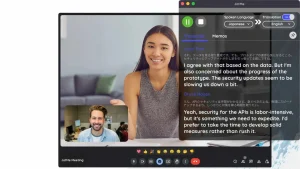If you want real traction in a crowded market, transcription services must feel effortless from first contact to final file. Buyers judge transcription services in minutes, not months, and they remember whether your handoff was smooth, your edits were thoughtful, and your turnaround matched the promise. The strongest providers design transcription services as an end-to-end system rather than a task. That is how TransLinguist frames its own transcription and caption programs, and it is a playbook any serious shop can adopt to rise above the noise.
Rethink the promise
Trade adjectives for proof
Most pages claim accuracy and speed. Fewer show how those outcomes happen. Publish a clear service definition that names the levels you deliver, such as verbatim transcripts, clean read copies, and caption-ready text. State the accuracy target you aim for and the usual turnaround for each tier. When your language is specific, trust follows.
Make outcomes visible before purchase
Offer a short sample workflow that mirrors a real client journey. Show an intake form, a terminology sheet, and a clip with side-by-side results. This simple demo reduces hesitation and shortens the sales cycle because buyers can see what good looks like in your hands.
Build a submission experience that people enjoy
Reduce friction at the door
Clients abandon uploads that feel clumsy. Keep file naming rules simple, accept common formats, and allow large files without drama. Add plain language tips for mic placement and room setup. Small nudges improve audio quality, which is the single biggest driver of accuracy.
Collect the right context once
Ask for speaker names, slide decks, acronyms, and the preferred style of numbers and dates. Save these as a living profile so returning customers never fill the same form twice. Consistency is a competitive edge, and it begins with what you remember.
Engineer accuracy upstream
Turn glossaries into a habit
The teams that win repeat work treat terminology as a product. Build glossaries for brand names, legal clauses, clinical terms, and interface strings. Keep them searchable and always current. Editors use these references to police voice and phrasing so every transcript sounds like it belongs to the same company.
Use a layered review without slowing delivery
Split the workflow into clean steps. First pass operators handle bulk typing. Senior editors verify names, numbers, and tricky passages. A final checker handles style and formatting. This assembly raises quality without turning every job into a bespoke marathon.

Offer formats that solve real problems
Start with three defaults
A verbatim transcript satisfies legal and research teams. A clean read version helps communication and training. A caption-aligned export feeds media and learning platforms. When you package these together, one recording serves the entire organization.
Add value where others stop
Include timestamps that jump to moments in the audio. Provide basic speaker tags so readers can scan arguments and assign actions. For video, deliver subtitle files that play nicely on mobile. Quality in the file is what earns you a second order.
Blend people and automation with intent
Let automation carry speed
Real-time speech recognition accelerates first pass capture and makes live notes possible during events. Use it when time matters and the stakes are moderate. It saves hours without locking you into the mistakes of a raw machine output.
Keep humans where nuance matters
Specialist editors protect meaning in legal, medical, and public sector material. They understand register and tone, and they know when to challenge a garbled sentence rather than guess. This human layer is not a cost; it is your insurance policy for brand and risk.
Win on security and governance
Make the guardrails obvious
Explain how you protect files in transit and at rest, who can access work in progress, and how long you retain data. Give customers a simple setting to choose retention by project. Buyers sleep better when these choices are visible and easy to change.
Leave a trail that answers questions
Maintain an internal log that records who touched a file, when they made edits, and which version shipped. You will use this log rarely, but when a customer audits a process or disputes a change, the record saves the day.
Help clients reuse what they already paid for
Turn transcripts into a content engine
Provide short summaries for leaders, pull quotes for communications, and suggested chapter markers for training videos. When one hour of audio becomes four useful assets, your value moves from cost center to multiplier.
Support multilingual needs without chaos
If your clients operate across regions, pair transcripts with subtitles and translated summaries. A consistent terminology base keeps versions aligned. TransLinguist uses this approach to stretch a single event across markets without rework, and it is a model worth borrowing.
Measure what matters and publish the wins
Track signals that buyers care about
Report on time delivery rate, edit rate after delivery, and reuse rates for captioned replays. Share how glossary coverage improved recognition over time. These numbers prove you are not only fast but also improving with each project.
Tell the story in the client’s language
Replace internal jargon with outcomes like fewer repeat sessions, clearer handovers, or faster compliance reviews. When clients can retell your impact to their leadership, renewals become routine.
A TransLinguist-inspired blueprint you can apply
Intake
Collect files, context, and terminology once. Confirm the chosen output formats. Avoid back and forth by front-loading clarity.
Production
Clean audio, run a first pass capture, and route the draft through editors who know the domain. Apply the glossary and style sheet throughout.
Delivery
Ship the promised formats and a short summary of any unresolved questions. Offer add-ons such as subtitles, translated summaries, or a clean read edit if they were not in scope.
Follow up
Send a micro report with delivery time, edit rate, and any glossary updates. Invite feedback. This is how a single job grows into a program.
Conclusion
In a market filled with similar claims, the providers that stand out make transcription services simple to start, predictable to receive, and easy to reuse. They engineer accuracy upstream, package outputs for every team, and document the guardrails without asking customers to chase them. That is the path TransLinguist follows across transcription, captions, and subtitles, and it is a path your shop can take starting today. If you want transcription services that win on clarity and trust, build the system that makes every delivery feel inevitable. Then invite clients to see the difference in their metrics and in their calendars. With that mindset, transcription services become the backbone of smarter content and faster decisions.
FAQs
How do I raise accuracy without slowing my delivery?
Invest in better audio at intake, maintain a live glossary, and split work into clear roles. A fast first pass plus expert editing is quicker than a single overloaded step.
Which three formats should every order include?
Ship a verbatim transcript, a clean read version, and a caption-aligned export. Most teams will use all three inside a month.
What is the simplest way to reduce client questions?
Send a one-page run of show with mic tips, file naming rules, and a terminology sheet. You will get cleaner audio and fewer clarifications.
When should I use automation?
Use it for speed on live notes and first pass capture. Keep editors in the loop for anything public, legal, or clinical so nuance survives.



